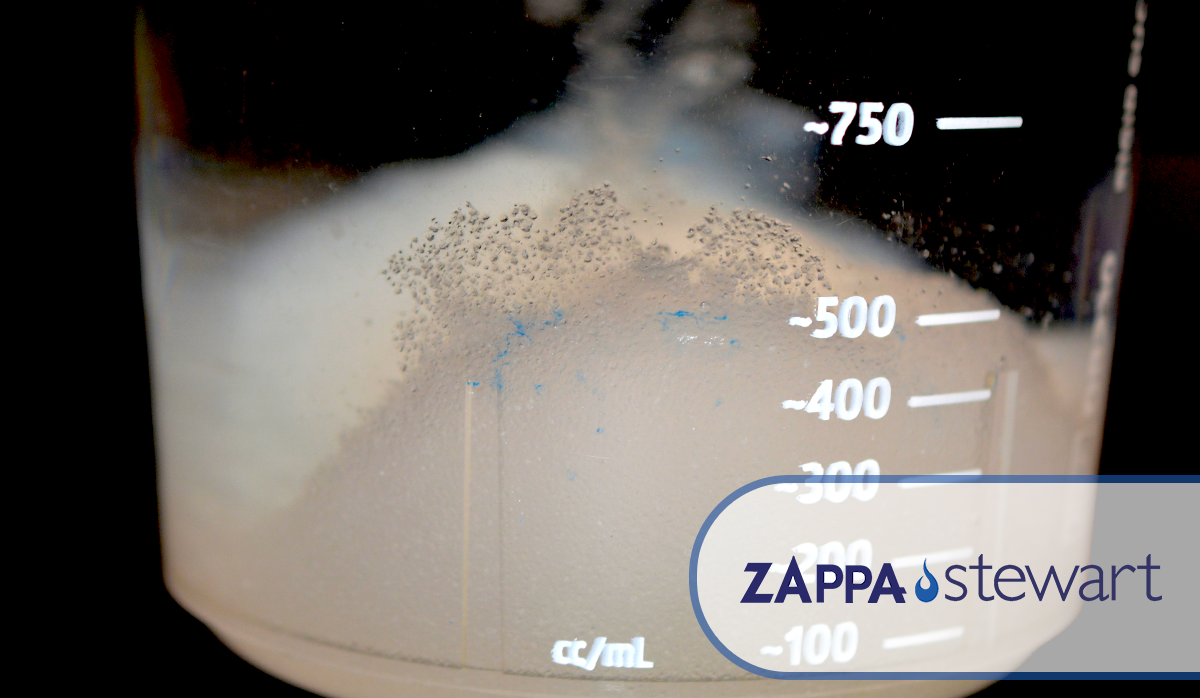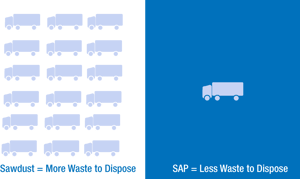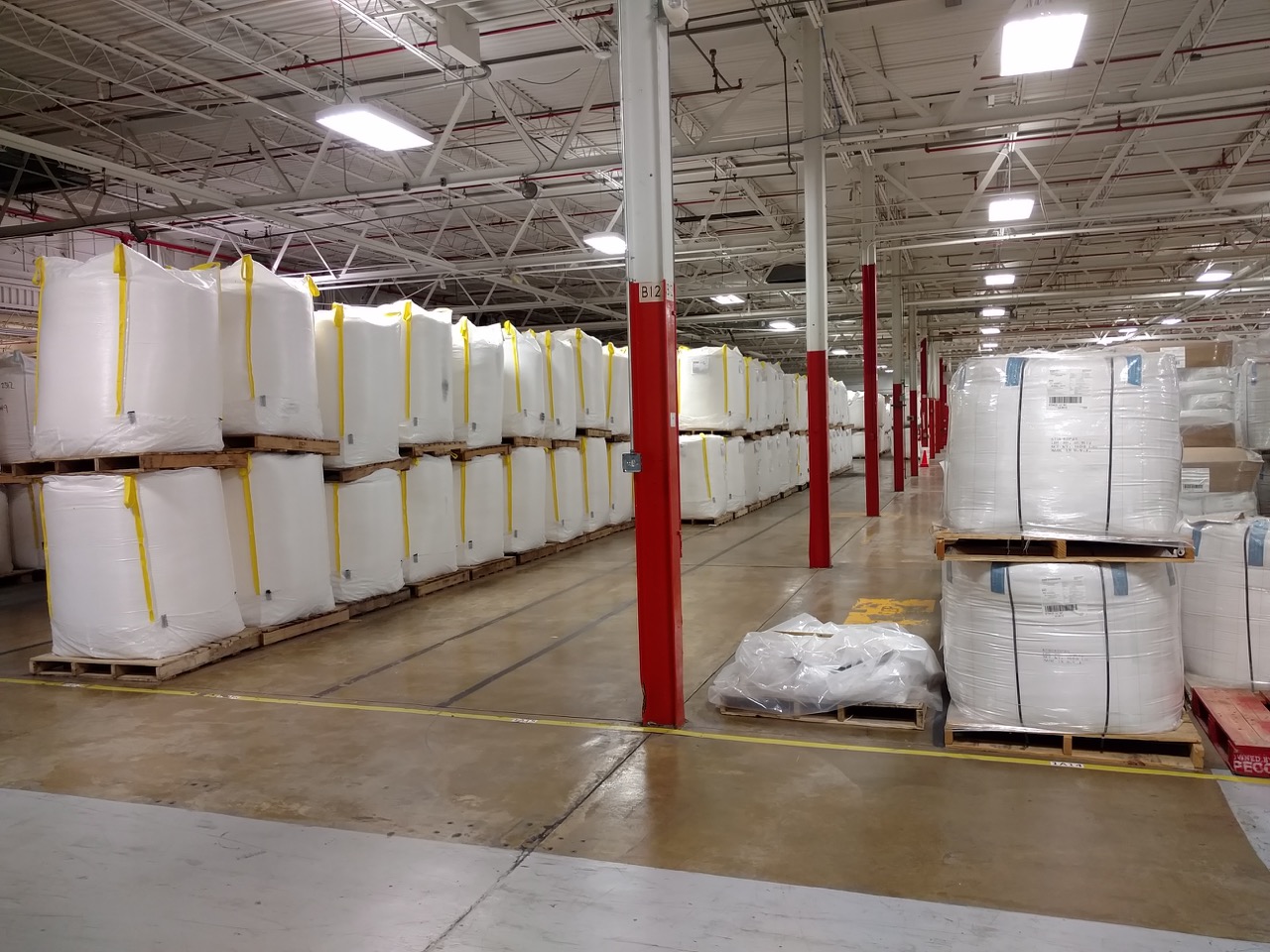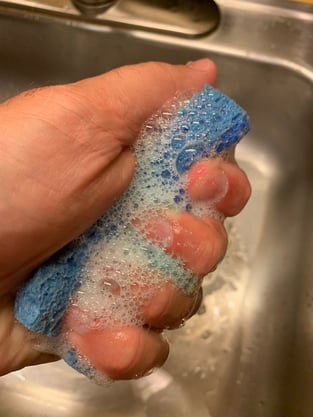
Superabsorbent polymers (SAPs) are used in many industries to reduce the challenges and risks associated with managing liquid waste. Waste solidification is the process utilized by environmental waste management professionals to render liquid waste into a solid state that can be more easily managed, transported, and disposed. To learn more about the benefits of SAP technology, the Top 5 Reasons to Solidify with SAPs are provided below.
1. SAPs Help Save Money
Superabsorbent polymers (SAPs) feature superior absorbency compared to commodity absorbents, such as sawdust, fluff, or pellets. For example, to solidify 1000 gallons of water, an environmental contractor would need to use approximately 8,000 – 16,000 pounds of sawdust. The same volume of water would require only 40-80 pounds of SAP. While sawdust and other commodity materials usually have a lower purchase price than SAPs, the total project costs incurred through handling, mixing, transporting, and disposing of the massive quantities of inefficient material typically exceed the costs associated with SAPs.
This waste solidification cost calculator compares SAPs and sawdust head-to-head. The input values can be adjusted as needed for specific project parameters. As you can see, even when sawdust is free, the excessive weight of the material causes transportation and disposal costs, and ultimately total project costs, to exceed the final outlays that result from solidification with SAPs.

2. SAPs Help Save Time

As explained above, commodity absorbents, such as sawdust, often require 200 times as much material as SAPs to solidify the same quantity of liquid-bearing waste. That means that for each 50-pound bag of SAP that an environmental remediation operator has to off-load from the delivery truck, stage on-site, mix into the waste matrix, and move to a roll-off box, the operator would have to manage 200 times as much material (10,000 lbs) if he/she were using sawdust.
More material to manage means more time spent managing the material, longer project completion times, and fewer project opportunities. The environmental services market is very competitive, and the most efficient companies will prevail. Commodity absorbents are inefficient and can cost you your competitive edge. Superabsorbent polymers maximize efficiency so you can complete the project faster and stay in front of your competition.
3. SAPs Are Safe

Safety is on every environmental professional’s mind as the result of decades of successful industry-wide health and safety initiatives. While many solidification reagents (think cement, lime, fly ash) present just another potential health hazard for the health and safety professional, SAPs are manufactured with safety in mind. The modern baby diaper -- likely the most common application of SAPs -- has been revolutionized by superabsorbent polymers. Diapers containing SAPs are in intimate contact with precious resources (babies!) every day across the globe, with no hazards having been reported. Consumer meat packaging utilizes SAPs to remove blood from the surface of meat, a practice that helps prevent the spread of pathogens. SAPs are inert materials; therefore, they do not leach chemicals into the environment. In contrast, cement and lime present many hazards in the field: inhalation dangers, burns to skin, potential to leach heavy metals into the environment, and possibly dangerous exothermic reactions. Not only do SAPs help environmental professionals avoid additional risks on an environmental site, they make the world a safer place.
4. SAPs Are Always Available
Commodity absorbents are often sourced as waste materials from other processes. The benefit of using such materials is that the purchase price is usually cheap or free (See Reason #1). However, one of the many downsides to using waste materials for environmental projects is that the supplies of waste materials are unreliable. If the process that generates the waste material shuts down for some reason, the supply of absorbent material can disappear. When planning an environmental treatment or remediation project, reliability of supplies is highly critical. Delaying a project due to unavailability of treatment reagent would be bad. Stopping work during a project because treatment reagent supply became unavailable likely would be even worse.

SAPs are designed and manufactured for environmental treatment applications, are always available, and can be shipped to any project site within a few days. Gambling on the availability of a waste material for your client’s bottom line is a risk that should be avoided. SAPs remove the uncertainty of material availability, leaving environmental professionals to focus on mitigating other uncertainties and completing projects on time and under budget.
5. SAPs Retain Liquid, Not Just Absorb
 Any absorbent material can soak up large volumes of liquid. The factor that sets SUPERabsorbent polymers apart from regular absorbents (like sponges) is SAPs’ ability to retain the liquid that it absorbs. If you were to place a sponge in a bowl of water, the sponge would become saturated with water. But if you applied a small amount of pressure to the sponge, the water would be released.
Any absorbent material can soak up large volumes of liquid. The factor that sets SUPERabsorbent polymers apart from regular absorbents (like sponges) is SAPs’ ability to retain the liquid that it absorbs. If you were to place a sponge in a bowl of water, the sponge would become saturated with water. But if you applied a small amount of pressure to the sponge, the water would be released.
However, if you mixed SAPs into a bowl of water, the SAPs would draw the water into the SAPs’ crystal structure and upon moderate pressure, no water would be released. The property that describes the retention of liquid under pressure is Absorbency Under Load (AUL), a feature that has real world applications in the environmental industry.
Liquid-bearing waste that is contained in a dump truck en route to a disposal facility can experience vibrations that can cause liquid to be released from a commodity absorbent material. A leaking dump truck will cause many regulatory and logistical problems for environmental professionals and their clients.
Liquid that is solidified, or more accurately “bulked,” with a commodity absorbent like sawdust can pass the EPA Paint Filter test and be accepted into a landfill. However, once the bulked material is deposited in the landfill, the sawdust will release the liquid, contributing to increased leachate volume that the landfill operators must manage. The rapid increase in horizontal directional drilling (HDD) activities in North America in the last decade has come with a corresponding increase in HDD waste fluids that are often bulked with sawdust, disposed of in a landfill, and quickly released, causing leachate management problems. Many disposal facilities are considering a requirement that liquids be properly solidified with non-biodegradable, liquid-retaining materials such as SAPs.
For more information on the diverse applications of superabsorbent polymers, please contact us.






